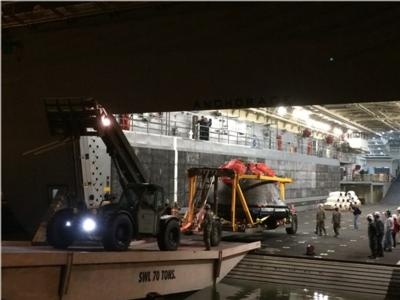Thu, Dec 11, 2014
Engineering Teams Analyzing Heat Shield, Data Recorders From Flight Test
Engineers are getting their first look at the Orion spacecraft following its successful flight test and recovery on Dec. 5. With the spacecraft recovered from the Pacific and brought to port in San Diego, technical teams are examining flight data recorders and samples of the heat shield to learn as much as possible about the performance of key systems during the test.

“The 1,200 on-board sensors will provide us an ocean of information about everything from the effects of space radiation on our avionics to the environment inside the crew cabin,” said Mike Hawes, Lockheed Martin vice president and Orion program manager. “What we learn from this flight will improve Orion’s designs and technology, and help us make future vehicles the best they can be.”
In San Diego engineers have removed samples of the heat shield to examine its performance and ablation rates during re-entry. The samples, along with select data recorders, will be brought to nearby Lockheed Martin facilities for processing. This analysis will help the technical team get a head start in determining how to optimize the development of future heat shields.
Orion will be loaded on a special truck for an estimated two-week trip across the country to Kennedy Space Center in Florida, where NASA and Lockheed Martin engineers will disassemble it and thoroughly examine its structure, computers and instrumentation. In March, as part of the Exploration Flight Test-1 (EFT-1) contract, Lockheed Martin will provide a complete data analysis report to NASA which includes information about the vehicle’s performance and recommendations based on the results.
The EFT-1 crew module will next be used for Ascent Abort Test 2, which is a test of the launch abort system. Orion’s launch abort system is equipped with three powerful motors capable of pulling the capsule and crew a mile up and a mile away from an emergency on the launch pad.
In addition, the Orion team has already begun procuring parts and manufacturing primary structures for the next spacecraft, which will be flown on the upcoming Exploration Mission-1 atop the powerful Space Launch System.
(Image provided by Lockheed Martin)
More News
Aero Linx: Model Aeronautical Association of Australia MAAA clubs are about fun flying, camaraderie and community. For over 75 years, the MAAA has been Australia’s largest fl>[...]
Touchdown Zone Lighting Two rows of transverse light bars located symmetrically about the runway centerline normally at 100 foot intervals. The basic system extends 3,000 feet alon>[...]
“Discovery and innovation are central to our mission at Virgin Galactic. We’re excited to build on our successful record of facilitating scientific experiments in subor>[...]
How To Get A Story On Aero-TV News/Feature Programming How do I submit a story idea or lead to Aero-TV? If you would like to submit a story idea or lead, please contact Jim Campbel>[...]
Student Pilot Reported That During Rotation, “All Of A Sudden The Back Of The Plane Kicked To The Right..." Analysis: The student pilot reported that during rotation, “>[...]
 ANN's Daily Aero-Linx (05.02.24)
ANN's Daily Aero-Linx (05.02.24) ANN's Daily Aero-Term (05.02.24): Touchdown Zone Lighting
ANN's Daily Aero-Term (05.02.24): Touchdown Zone Lighting Aero-News: Quote of the Day (05.02.24)
Aero-News: Quote of the Day (05.02.24) ANN FAQ: Contributing To Aero-TV
ANN FAQ: Contributing To Aero-TV NTSB Final Report: Cirrus Design Corp SR20
NTSB Final Report: Cirrus Design Corp SR20



